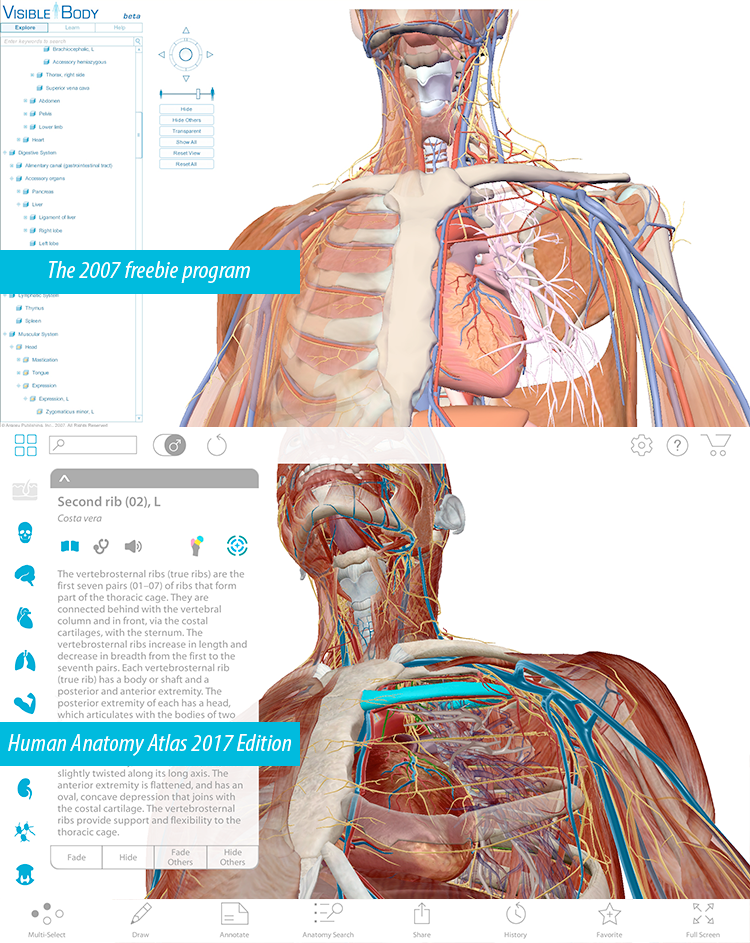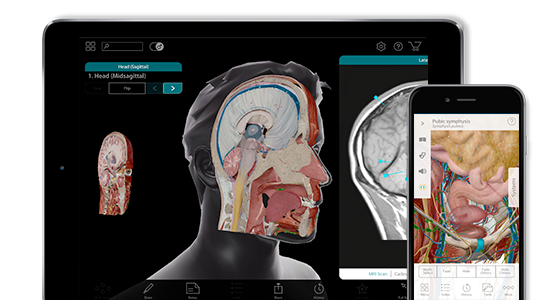High-Tech Classrooms: Learning with Virtual Human Anatomy
Posted on 1/19/17 by Maite Suarez-Rivas
Nine years ago, we did something risky: we took our company’s most precious assets—our interactive 3D anatomy models—and made them available to healthcare professionals, professors, and students.
For free.
(Remember: back in the day, free things on the internet were unheard of. The good stuff was behind paywall after paywall.)

Top image: the very first version of Human Anatomy Atlas released in the Winter of 2007.
Bottom image: Human Anatomy Atlas 2017 Edition.
What happened when we put Visible Body on the web for free?
The first version of Visible Body’s Human Anatomy Atlas was an Internet Explorer-only female model with about two thousand anatomical structures.
In a few months, over a million people signed up to try it out.
Healthcare professionals started using our content to communicate with patients. Students signed up to study more anatomy on their own. Instructors began using the 3D anatomy models in classroom presentations and for virtual anatomy lab activities; they wondered in comments to us and in newsgroups (remember those?) how to incorporate online anatomy visuals into the work they did outside of class and anatomy lab.
Okay, maybe it wasn't that surprising. Give people free tools and they will use them.
Visible Body had spent years creating highly accurate anatomy teaching videos for pharmaceutical and medical device companies, but by putting our models out on the web, we found a new audience: everyone else. Students, professors, doctors, healthcare professionals, and even just regular people—all who wanted to better understand how the body works. It was then that we realized we had a job to do: bring 3D anatomy to the world.
But why are more and more people using technology over textbooks in the classroom?
Welcome to the 21st century, where more people have access to mobile phones than they do toilets. There's about a 50% chance that you're reading this on your phone right now. As technology continues to become more integrated with our day-to-day lives, high-tech classrooms are fast becoming the norm, which means that some of the old ways of doing things get closer and closer to obsolescence.
Some of you might think the next thing I say is that anatomy textbooks are becoming obsolete. They're not—they're still the number one resource for credible information—but they're no longer the only anatomy resource available. Between sites like Wikipedia, Bartleby, Open Stax, YouTube, and companies that make 3D anatomy apps like Visible Body (us!), there is no shortage of different and cost-effective ways to learn.

And that's the name of the game, folks: differentiated learning. People learn things in different ways, and a complex subject like anatomy can't be boxed into one. It isn't just about memorizing parts of the body: it's visualizing where anatomical structures are in context, learning how shape and size give way to function, and understanding how structures interact within their systems and with the anatomy of others. 2D images and text explanations may not be enough, especially when you don't have a cadaver in front of you. Being able to see anatomy in a 3D space is incredibly important, because that's how anatomy exists. People are not flat images on a page; the way we learn anatomy can't be just that, either.
What is fueling innovation in the learning and teaching of human anatomy?
So much has changed since that fateful day in 2007 when we first put our models out there, but the use of 3D anatomy apps—both in anatomy labs on college campuses and by medical students and practitioners—continues to grow in popularity.
Here are a few trends we've noticed:
- Hospitals rely on 3D visuals and online content for a good amount of their patient education and the continuing medical education they offer their healthcare professionals. (1, 2)
- The prediction that cadavers for anatomy lab courses would become scarce hasn't exactly come true (3); but other trends have introduced 3D anatomy apps as a growing resource in many anatomy dissection labs. These trends include the surge in online learning (4), issues related to using animals for dissection (5), and the demands on limited lab time at schools with fast-growing enrollments in healthcare related degrees (6).
- Apps for medical reference and anatomy teaching have flourished. It's not just students who pull out their phones first before they reach for an anatomy atlas. Healthcare professionals rely on medical apps for patient communication, records management, reference, and more! (7, 8)
- There are a growing number of high school students thinking about careers in healthcare and enrolled in human biology and Career and Technology programs focused on healthcare studies.
- For many visitors to our website, learning still starts with the free content we offer that visually communicates anatomy, physiology, and pathology. (Check our Anatomy Education Hub resources).
- Our suite of apps includes our award-winning flagship general reference atlas, and a series of other apps aimed at specific learners (like undergraduate anatomy & physiology students, and kinesiology, sports medicine and physical therapy specialists)
Are you a teaching anatomy or human biology? Check out our amazing visual and interactive human anatomy & physiology apps. Learn how your institution can get a site license or LMS integration so that you can leverage our 3D anatomy models and physiology animations in your college courses or career and technology education/health sciences curriculum.
Additional Sources:
(1) "A New Clinical Study Provides Evidence That Patient-Specific, Virtual Reality Based Preoperative Surgical Simulation Improves Surgical Efficiency for Neurovascular Surgery, Published in Journal of Neurosurgery." A New Clinical Study Provides Evidence That Patient-Specific, Virtual Reality Based Preoperative Surgical Simulation Improves Surgical Efficiency for Neurovascular Surgery, Published in Journal of Neurosurgery | Business Wire. Business Wire, Inc., 17 May 2016. Web. 19 Dec. 2016. <http://www.businesswire.com/news/home/20160517005670/en/Clinical-Study-Evidence-Patient-Specific-Virtual-Reality-Based>.
(2) Scher, David Lee. "Five Ways Virtual Reality Will Transform Healthcare." Samsung Business Insights. Samsung, 24 June 2016. Web. 19 Dec. 2016. <https://insights.samsung.com/2016/06/24/five-ways-virtual-reality-will-transform-healthcare/>.
(3) "Body Donations to Medical Schools Are up." CBSNews. The Associated Press, 17 Aug. 2016. Web. 19 Dec. 2016. <http://www.cbsnews.com/news/people-are-giving-more-of-themselves-these-days-literally/>.
(4) The Condition of Education - Postsecondary Education - Programs, Courses, and Completions - Distance Education in Postsecondary Institutions - Indicator November (2015)." The Condition of Education - Postsecondary Education - Programs, Courses, and Completions - Distance Education in Postsecondary Institutions - Indicator November (2015). U.S. Department of Education, Nov. 2015. Web. 19 Dec. 2016. <http://nces.ed.gov/programs/coe/indicator_sta.asp>.
(5) Gorman, Nicole. "Education World: School's Anatomy Lesson Intensifies Debate Over Animal Dissection in Classrooms." Education World: School's Anatomy Lesson Intensifies Debate Over Animal Dissection in Classrooms. Education World, Inc., 18 May 2016. Web. 19 Dec. 2016. <http://www.educationworld.com/a_news/school%E2%80%99s-anatomy-lesson-intensifies-debate-over-animal-dissection-classrooms-646730458>.
(6) "Employment of Healthcare Occupations Projected to Grow 19 Percent." U.S. Bureau of Labor Statistics. U.S. Bureau of Labor Statistics, 17 Dec. 2015. Web. 19 Dec. 2016. <https://www.bls.gov/ooh/healthcare/home.htm>.
(7) "The Best Online Tools and Technology for Your Nursing Career." EveryNurse.org. EveryNurse.org, 30 Jan. 2014. Web. 19 Dec. 2016. <http://everynurse.org/the-best-online-tools-and-technology-for-your-nursing-career/>
(8) Milligan, Lauren. "Top 10 IPad Apps for Physical Therapists." WebPT. WebPT, 04 May 2016. Web. 19 Dec. 2016. <https://www.webpt.com/blog/post/top-10-ipad-apps-physical-therapists>.



